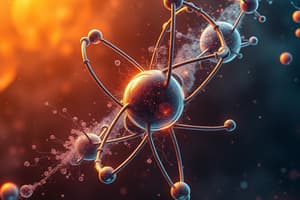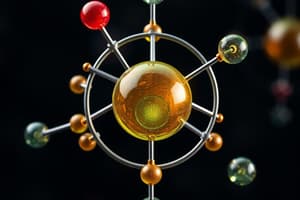Podcast
Questions and Answers
What are neutrons?
What are neutrons?
- No charge (Neutral) and 1 atomic mass unit (correct)
- Positive charge found in the nucleus
- Negative charge found outside the nucleus
- Positive and neutral charged particles
Where are protons located?
Where are protons located?
In the nucleus
Electrons have a positive charge.
Electrons have a positive charge.
False (B)
What does the atomic number represent?
What does the atomic number represent?
What is the mass number?
What is the mass number?
Which of the following statements about isotopes is true?
Which of the following statements about isotopes is true?
What does the stability of isotopes depend on?
What does the stability of isotopes depend on?
What is the first level of electrons characterized by?
What is the first level of electrons characterized by?
What is the purpose of a flame test?
What is the purpose of a flame test?
What does the bright line spectrum represent?
What does the bright line spectrum represent?
What does the term 'density' refer to?
What does the term 'density' refer to?
Metals are typically found on which side of the periodic table?
Metals are typically found on which side of the periodic table?
Nonmetals are good conductors of heat and electricity.
Nonmetals are good conductors of heat and electricity.
The energy needed to remove an electron from an atom is known as ______.
The energy needed to remove an electron from an atom is known as ______.
What does electronegativity measure?
What does electronegativity measure?
Flashcards are hidden until you start studying
Study Notes
Atomic Composition
- Neutrons carry no charge and have a mass of 1 atomic mass unit; they are located in the nucleus.
- Protons possess a positive charge and are also found in the nucleus.
- Electrons are negatively charged and reside outside the nucleus.
- The atomic number indicates the number of protons (and electrons) in an atom.
Atomic Structure
- An atom consists of a nucleus at its core, containing protons and neutrons, with electrons orbiting outside.
- The mass number is the total count of protons and neutrons in an atom.
Isotopes and Nuclide Symbols
- Isotopes share the same atomic number but vary in mass number due to differing neutron counts.
- Nuclide symbols serve as shorthand to denote an element's atomic number and mass number.
Nuclear Characteristics
- Nuclear charge, determined by the atomic number, reflects the total positive charge of the nucleus.
- The stability of isotopes is influenced by the neutron-to-proton ratio.
Electron Configurations and Energy Levels
- Energy levels can accommodate a maximum number of electrons, with the first level housing those with the lowest energy.
- Electrons in outermost levels carry the highest energy.
- Valence electrons are those located in the outermost energy level and dictate chemical behavior.
Atomic Mass and Properties
- Average atomic mass is calculated by taking the sum of the percent abundance of each isotope divided by 100, then multiplied by the mass of the isotope.
- Conducting a flame test can excite an electron, causing it to jump to a higher energy state, which produces a bright line spectrum when viewed through a prism.
Historical Experiments and Models
- Rutherford's Gold Foil Experiment revealed that atoms consist of a dense, positively charged nucleus surrounded by mostly empty space.
- The Wave Model of the Atom introduces the concept of orbitals as regions where electrons are likely to be found.
Periodic Table and Atomic Properties
- The modern periodic table organizes elements by increasing atomic number.
- First ionization energy is the energy required to remove an electron from an atom, while electronegativity describes an atom's ability to attract electrons.
- Melting point and boiling point refer to the temperatures where solids become liquids and liquids become gases, respectively.
Density and Atomic Radius
- Density is defined as mass per unit volume, while atomic radius indicates the size of an atom.
Classification of Elements
- Metals typically appear on the left side of the periodic table, characterized by low electronegativity, low ionization energy, malleability, ductility, and excellent conductivity.
- Nonmetals are predominantly found on the right side, exhibiting high electronegativity, high ionization energy, brittleness in solid form, and poor conductivity.
- Metalloids possess properties that are intermediate between metals and nonmetals.
Studying That Suits You
Use AI to generate personalized quizzes and flashcards to suit your learning preferences.




